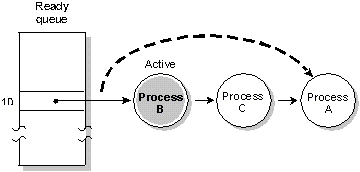It is one of the oldest, simplest, fairest and most widely used scheduling algorithms, designed especially for time-sharing systems. A small unit of time, called timeslice or quantum, is defined. All runnable processes are kept in a circular queue. The CPU scheduler goes around this queue, allocating the CPU to each process for a time interval of one quantum. New processes are added to the tail of the queue.
The CPU scheduler picks the first process from the queue, sets a timer to interrupt after one quantum, and dispatches the process.
If the process is still running at the end of the quantum, the CPU is preempted and the process is added to the tail of the queue. If the process finishes before the end of the quantum, the process itself releases the CPU voluntarily. In either case, the CPU scheduler assigns the CPU to the next process in the ready queue. Every time a process is granted the CPU, a context switch occurs, which adds overhead to the process execution time.

The CPU scheduler picks the first process from the queue, sets a timer to interrupt after one quantum, and dispatches the process.
If the process is still running at the end of the quantum, the CPU is preempted and the process is added to the tail of the queue. If the process finishes before the end of the quantum, the process itself releases the CPU voluntarily. In either case, the CPU scheduler assigns the CPU to the next process in the ready queue. Every time a process is granted the CPU, a context switch occurs, which adds overhead to the process execution time.

0 comments:
Post a Comment